Info
Teatro Massimo
Season 2024/2025
- application of reduced rates reserved for cral and affiliated associations.
- Reduced rate for guided tour tickets.
The Teatro Massimo
Place along the extension of one of the two main cities of the Teatro Massimo is a link between the ancient and the new. Elegant and rigorous, powerful for its structure designed with refined sense of form, it requires more than that to be an important center for the production of shows and even for its monumental beauty.
The theater is open daily from 9.30 to 18.
The visit is available in Italian, English, French, Spanish and German.
For groups we can, by appointment, arrange tours at different times.
Guided tours
Tickets
Full price: € 8.00
Reduced: € 5.00 (under 25, over 65) br Reduced ticket for groups (minimum 20 persons or holders Card PMO): € 6.00
Reduced ticket students € 3.00
Free admission for children under six years.
Duration 30 minutes
News. The terrace is open
Breathtaking views of Palermo from the top of one of his most iconic landmarks. The visit to the terrace, in addition to the regular guided tour of the theater, is carried out on booking every day from 9.30 to 18.
Tickets: € 20
Information and reservations
phone 091 605.32.67
visiteguidate@teatromassimo.it br br History
Even before the unification of Italy about the need to Palermo for a new, spacious and modern opera, so much so that in 1859 identified an area of ​​Marina Square as the location of the new building, to be entitled to Ferdinand II Bourbon. After the Unification of Italy, the city council instead identified the area in the Porta Maqueda, proceeding to the expropriation of land where there were three churches and many monasteries: the Monastery and Church of the Stigmata, the Asked and San Jeronimo Giuliano, and the Church of Sant'Agata, built on the site that would be to the house of Sant'Agata. Tradition says that a nun known as the "nun", whose grave was desecrated during the construction work, still roams the theater.
On 10 September 1864, Mayor Antonio Starabba, Marquis of Rudin, who succeeded Mariano Stabile, announced a competition to "provide for the lack of a theater in that same relationship to civilization grew and 'needs of the population", open to Italian and foreign architects . The deadline was set for September 9, 1866, the date then extended by six months for various reasons, "including, in addition to the importance and magnitude of the project, not least is the imminence of the war [the third war of independence ] that certain reputed artists competitors will take part. " The participants were 35, twelve of them foreigners. The jury was chaired by Gottfried Semper, the architect author of the Semperoper in Dresden and committed in those years in the creation of the Ringstrasse in Vienna.
September 4, 1868 the jury formulated the ranking of the top five winners, giving the first prize to Giovan Battista Filippo Basile, a renowned architect from Palermo, while the fourth place was the project of Giuseppe Damiani Almeyda: Mayor, Salesio Balsano, took care to announce Basile to the outcome of the competition accompanied by his congratulations. There was a waiting period, also due to the ambiguity of the contract, which provided that all five winning projects remain municipal property and that among them the city council would have to choose what to accomplish. The foundation stone was laid on January 12, 1875, anniversary of the Sicilian revolution of 1848, in Piazza Giuseppe Verdi, with the participation of all major city authorities and a speech by Baron Nicolo Turrisi Colonna. The work was suspended in 1878 and resumed in 1890 with the aim to complete them in time for the following year and always showroo by Giovan Battista Filippo Basile, who died a few months later, on June 16 1891. The succeeded Ernesto's son, also an architect, who agreed to complete the work in progress of the father at the request of the City of Palermo, completing the designs necessary for the continuation of the work of theater. The inauguration took place on May 16 1897 with Giuseppe Verdi's Falstaff, who still work had never been performed in Palermo, under the direction of Leopold Mugnone: ticket prices ranged from 80 pounds of the stages of the second row of the gallery at 3 pounds .
Massimo theater at the time of its inauguration was with its 7730 square meters of the third largest theater in Europe, second only to the works of Paris and Vienna. The two groups with bronze lions flanking the grand staircase depicting the tragedy, by Benedetto Civiletti, and Opera, opera instead of Mario Rutelli, who also designed the Quadriga overlooking the Politeama Garibaldi. At the end of the steps, a portico with six Corinthian columns welcomes the viewer. The frieze at the top bears the inscription: "The Art renews people and reveals life. Compartment of the scenes where the beloved is not intended to make ready the future. " The dome in the hall has a diameter of 28,732 meters and consists of a steel structure covered with bronze scales, dominated by a large vase also inspired Corinthian. Antonio Ugo are due bust of Giuseppe Verdi and that of Giovanni Battista Filippo Basile, while several sculptural reliefs are the work of Salvatore Valenti. Among the painters who decorated the rooms of the theater, Ettore De Maria, Michele Corteggiani, Luigi Di Giovanni, Rocco Lentini, Giuseppe Enea, Enrico Cavallaro, while Joseph Sciuti depicted the procession of the coronation of Roger II in large curtain decorated.
In the early decades of the theater it was entrusted to private firms, often different from year to year, until 1935, when by a decree of the Minister of Popular Culture was proclaimed Ente Autonomo Theatre, and the following year took on the official name of body Autonomo Teatro Massimo of Palermo. In 1974 the theater was closed for renovations, which last until May 12, 1997, when the theater was reopened with a concert conducted by Franco Mannino in the first part and the second part by Claudio Abbado with the Berlin Philharmonic.
Immagini:
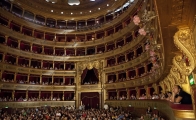 | 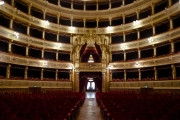 | 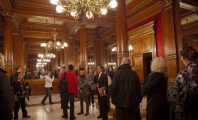 | 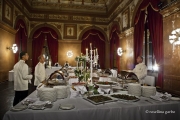 | |
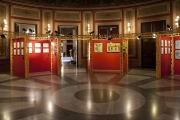 | 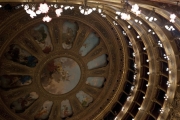 | 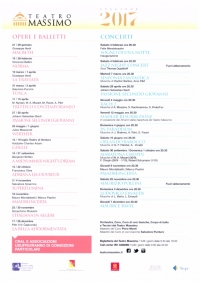 | 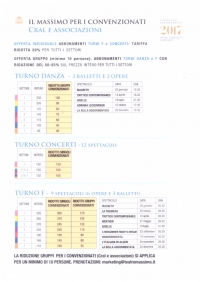 |









